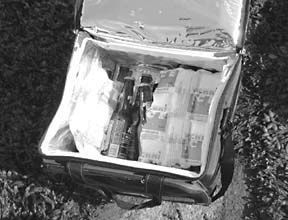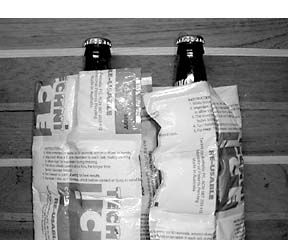Techni-Ice, invented in Australia, is meant to act as a substitute for ice, and it does a good job of it—better, in our opinion, than a hard plastic cold-pack, and much better than the flexible blue cold-packs sold in drugstores for twisted ankles.

Techni-Ice (you want the Heavy-Duty Reusable model) is sold by distributors around the country through Techni-Products in North Carolina. It comes in 25 x 39cm (10 x 15″) sheets, which sell for roughly $8 each, or less if you buy more sheets. The sheets are like quilts, with each slightly porous cell containing a quantity of water-absorbing fabric that in turn contains a refrigerant polymer.
To get the product working, you immerse the sheets in water and scrunch the cells around to make them absorb the liquid. When the cells are puffed up, you put the sheets in the freezer and freeze them hard. They can then be used to wrap an ankle or a beer bottle, or to line a cooler, or do anything that you’d normally use a cold pack for. (You can also put them in a microwave and use them as a hot pack—very handy.)
We tested Techni-Ice against a blue ice pack and real ice by putting all three, in equal volume, inside three identical coolers, each of which contained one bottle of beer, two cans of soda, one pear, and one sandwich. We put a thermometer in each cooler and left them outside in the sun in 80-degree temperature for four hours.
When we opened the coolers for lunch, the inside temperatures were as follows: Blue cold-pack: 61 degrees. Real ice (in Ziploc bag): 58 degrees. Techni-Ice: 56 degrees.

Both the blue cold-pack and the Techni-Ice had gone soft, while there was still some solid ice left in the Ziploc bag. We gave the water from the melted ice to our dog, who was in dire need of it.
This brings up the important difference between real ice and fake ice in any form: Real ice (as you may know) is fresh water; once it loses its solid shape, it’s still useful as a liquid. In our next, less formal experiment, we found that real ice was significantly better suited for immersion in glasses of vodka than Techni-Ice; furthermore, in its liquid form it was available the next morning for dog, tea, and coffee.
So, for us, Techni-Ice doesn’t replace Water-Ice. It does, however, easy outpace the standard cold-pack brick: Techni-Ice can be transported light and dry; it can be cut to fit any application in any cooler; it can act as both cold-pack and hot-pad; and it doesn’t form pools as it warms, so it won’t waterlog your groceries between the store and the boat.
Contact- Techni-Products, LLC, P.O. Box 339, Cornelius, NC 28031. 704/895-9622 or 704/895-3827.
































